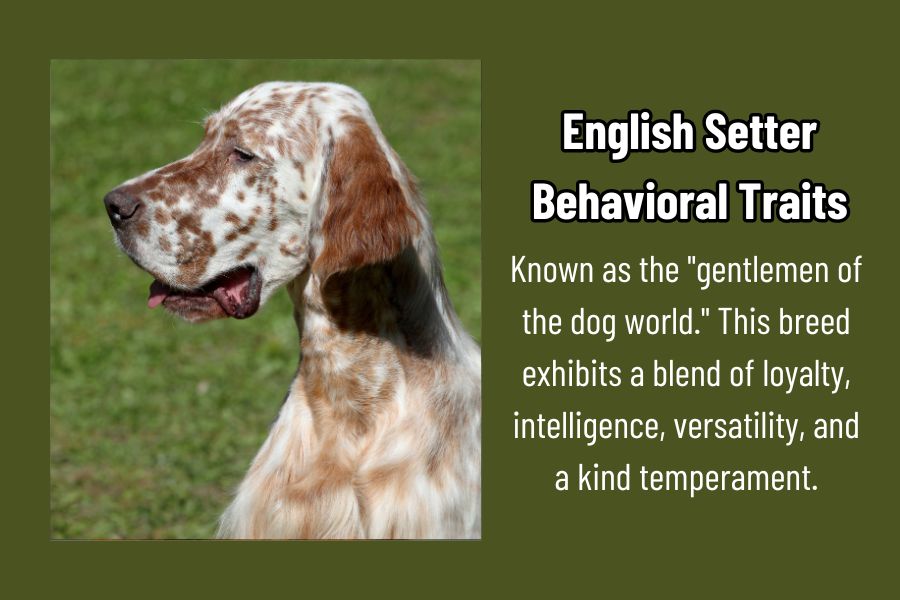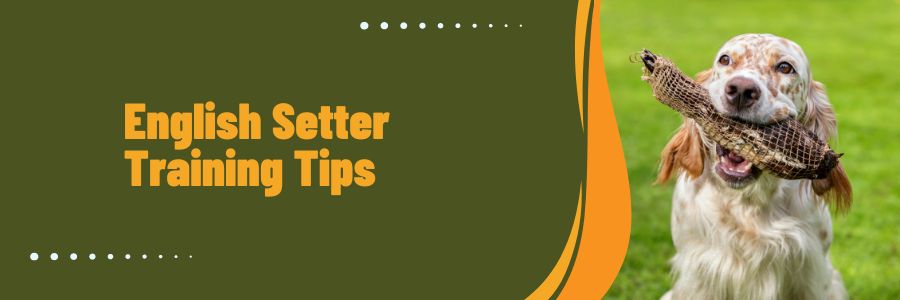Discover the friendly English Setter, an ideal bird dog. Learn about their history, traits, care, training tips and why they are great hunting dogs.
Introduction
Imagine a dog that embodies both elegance and efficiency in the field—the English Setter. Known for its friendly demeanor and exceptional hunting abilities, this breed is a favorite among bird hunters and dog enthusiasts alike. With a heritage rich in history and a personality that wins hearts, the English Setter stands out as a top choice for anyone looking to combine companionship with hunting prowess.
Whether you’re a seasoned hunter, a dog lover, or someone curious about this remarkable breed, this guide is for you. Let’s get started and discover what makes the English Setter breed such a beloved bird dog.
English Setter: Origin and History

The English Setter breed is steeped in tradition and heritage, cherished for its elegant appearance and exceptional hunting skills. Understanding the origins and history of this remarkable dog provides insight into its unique qualities and enduring popularity.
Ancestors
The English Setter history traces its roots back to the 14th century, where it was developed in England for the purpose of assisting hunters in locating and retrieving game birds. This breed is a result of crossbreeding between the Spanish Pointer, large Water Spaniels, and the Springer Spaniel. The combination of these breeds aimed to create a dog with an excellent nose, a keen eye for spotting game, and the stamina to cover vast hunting grounds.
Interesting facts: The English Setter is one of four British setter breeds developed. The other three breeds are the Irish Setter, Irish Red and White Setter, and the Gordon Setter. The English Setter was initially bred to “set” or crouch low when it found birds, allowing hunters to cast their nets over the game. This setting posture eventually evolved as hunting methods changed.
Evolution
Over the centuries, the English Setter has undergone significant evolution. By the 19th century, two distinct types of dogs had emerged: the Laverack and the Llewellin. The Laverack Setter, developed by Edward Laverack, emphasized beauty and conformation, making it a favorite in the show ring. On the other hand, R.L. Purcell Llewellin focused on enhancing the breed’s hunting abilities, resulting in the Llewellin Setter, known for its superior field performance.
Key milestones in the breed’s history include its introduction to America in the late 1800s and the subsequent popularity it gained among hunters and dog enthusiasts. By the early 20th century, the English Setter was firmly established as a premier hunting dog and a beloved companion.
Breed Status
Today, the English Setter enjoys a stable status both in the USA and worldwide. In the United States, there are approximately 10,000 registered English Setters, with similar numbers found in Europe and other parts of the world.
The English Setter has a dedicated following, with many enthusiasts drawn to its blend of beauty and functionality. The breed continues to thrive, thanks to the efforts of breeders and clubs dedicated to preserving its unique qualities.
Kennel Clubs
The English Setter is recognized by several major kennel clubs around the world, underscoring its global appeal and respected status. Notable clubs include:
- American Kennel Club (AKC) – Recognized in 1884
- United Kennel Club (UKC) – Recognized in 1902
- The Kennel Club (TKC) – Recognized in 1873
- Canadian Kennel Club (CKC) – Recognized in 1887
In addition to these prestigious organizations, there are numerous specialized clubs dedicated to the English Setter, such as the English Setter Association of America (ESAA) and the English Setter Club of Canada (ESCC), which play a crucial role in promoting and preserving the breed’s standards.
English Setter In Action

The English Setter hunting dog is renowned for its versatility and skill in the field, making it a prized companion for hunters. Let’s take a closer look at the setter in action as a hunting dog and as an impressive contender in dog shows.
Hunting
The modern English Setter gun dog is revered for its ability to hunt game birds like quail, pheasant, and grouse. Its innate hunting instincts and training make it an invaluable asset to hunters who rely on its expertise to locate, set and retrieve game.
The English Setter’s hunting prowess involves a meticulous process that showcases its intelligence, physical traits and natural instincts. To locate birds, the Setter uses its keen sense of smell to pick up a scent, moving gracefully through the terrain. The English Setter pointing process: when the dog identifies the location of the game, it adopts a distinctive “setting” posture, either crouching low or standing still, to indicate the presence of birds to the hunter.
Before the common use firearms, hunters relied on hawks and nets to capture game. The Setter would flush the birds out, and hunters would cast nets over them or use trained hawks to capture them. This method required the dog to have an exceptional sense of coordination and communication with the hunter.
In modern hunting, the Setter’s role as a gun dog has evolved. The dog points (normally in a crouching position) to the location of the birds, and once the hunter flushes the game, it remains steady to the shot, ensuring safety and efficiency. After the shot, the Setter retrieves the downed birds, demonstrating its remarkable training and dedication.
Show Setter
The Show Setter represents the breed’s aesthetic and conformational excellence, often differing in appearance and temperament from its field counterpart. While both field and show Setters share the same ancestry, selective breeding has led to distinct lines optimized for either performance or appearance.
Show Setters are bred to meet specific standards set by kennel clubs, focusing on attributes like coat quality, symmetry, and overall elegance. These dogs are trained to exhibit their poise and beauty in the show ring, where judges evaluate them based on how closely they adhere to the breed’s ideal characteristics.
In contrast, Field Setters are bred for their functional abilities, emphasizing traits such as stamina, scenting ability, and a strong work ethic. While they may not always possess the refined appearance of a Show Setter, their athleticism and hunting skills are unmatched.
Despite these differences, both types of English Setters are celebrated for their contributions to the breed’s legacy. Whether in the field or the show ring, the English Setter continues to captivate enthusiasts with its versatility and charm.
English Setter Physical Traits

The English Setter is not just a sight to behold but a marvel of canine engineering, combining elegance with functionality. From its impressive stature to its distinctive coat, every aspect of the English Setter’s physical traits speaks to its purpose and heritage.
Size (Length and Height)
The English Setter is a medium-to-large breed, with males typically standing between 24 to 27 inches at the shoulder and females slightly shorter at 23 to 26 inches. Length-wise, they are well-proportioned, giving them a balanced and graceful appearance. Their build allows them to cover ground effortlessly, whether they’re working in the field or prancing in the show ring.
Head and Muzzle
The head of the English Setter is long and lean, exuding a noble and alert expression. The muzzle is moderately deep, tapering slightly from the stop to the nose, which is usually black or dark brown. Their eyes are oval-shaped, with a kind and intelligent expression, often described as the window to their gentle soul. The ears are set low and hang gracefully, covered with silky hair that adds to their refined look. They also are known to have a soft mouth for retrieving birds.
Body Structure and Weight
The English Setter boasts a strong yet elegant body structure. Males typically weigh between 65 to 80 pounds, while females range from 45 to 70 pounds. Their chest is deep, providing ample lung capacity for endurance, and the back is level with a slight arch over the loin, contributing to their agility and strength. Their well-muscled frame is designed for both stamina and speed, crucial traits for a hunting dog.
Coat Type and Colors
One of the most striking features of the English Setter is its coat. They have a medium to long coat that is silky and slightly wavy, with feathering on the chest, legs, and tail. The colors are as diverse as they are beautiful, ranging from the classic blue belton (white with black speckles) to orange, lemon, liver belton, and tricolor (blue belton with tan points). This array of colors not only adds to their visual appeal but also aids in camouflage during hunts.
Keen Senses
The English Setter is equipped with highly developed senses, particularly their sense of smell, which is pivotal for their role as a hunting dog. Their acute olfactory abilities enable them to detect faint scents over long distances, making them excellent at locating game birds. Their hearing and vision are also sharp, allowing them to react quickly to the hunter’s commands and the movement of prey.
Tail Structure and Purpose
The tail of the English Setter is a thing of beauty and utility. It is long and tapers to a point, carried level with the back or slightly below. The tail is feathered with long, silky hair, adding to the breed’s overall elegance. In the field, the tail acts as a rudder, helping the dog maintain balance and agility while moving through varied terrains. It also serves as a visual signal to the hunter, indicating the dog’s excitement and focus.
Endurance
Endurance is a hallmark of the English Setter. Bred to work long hours in the field, this breed possesses remarkable stamina. They are capable of maintaining a steady pace over extended periods, whether they’re covering large swathes of land during a hunt or participating in field trials. Their well-developed muscles and cardiovascular health are a testament to their breeding and training.
Life Expectancy
The English Setter typically enjoys a lifespan of 10 to 12 years. With proper care, nutrition, and regular veterinary check-ups, some Setters can live even longer, providing many years of companionship and service to their owners.
Gestation Period and Litter Size
The gestation period for the English Setter is approximately 63 days. A typical litter size ranges from 6 to 8 puppies, though it’s not uncommon for a Setter to have slightly fewer or more. The puppies are born with a short coat and begin to show their distinctive markings as they continue to grow.
English Setter Behavioral Traits

The English Setter is celebrated not only for its physical attributes but also for its distinctive behavioral traits. Known as the “gentlemen of the dog world,” these dogs exhibit a blend of intelligence, versatility, and a kind temperament that makes them exceptional companions both in the field and at home.
Prey Drive
The English Setter has a strong prey drive, a trait honed over centuries of hunting heritage. Their natural proclivity to hunting is crucial for their role as bird dogs. They are naturally inclined to point and set, indicating the presence of birds to the hunter. Their prey drive, combined with their exceptional scenting ability, makes them outstanding hunting partners.
Intelligence
Renowned for their sharp minds, English Setters are highly intelligent dogs. They possess the ability to learn quickly and adapt to various situations, whether it’s following complex commands during a hunt or mastering new tricks at home. This intelligence also means they can sometimes be a bit independent-minded, requiring consistent and engaging training methods to keep them focused.
Versatility
While primarily known for their hunting prowess in the field, they excel in a variety of roles, including as family pets, therapy dogs, and competitors in dog sports and show competitions. They also can thrive in different environments, from the countryside to urban settings, as long as they receive adequate exercise and mental stimulation.
Temperament
Often referred to as the “gentlemen of the dog world,” English Setters are known for their calm and friendly temperament. Despite their hunting background, they are typically sociable, affectionate and gentle, making them great companions in the field and at home.
Trainability
English Setters are generally very trainable due to their intelligence and eagerness to please. Positive reinforcement techniques, such as treats and praise, work particularly well with this breed. However, they can sometimes be a bit stubborn or distracted by scents and sounds, so patience and consistency are key. Early socialization and obedience training are essential to ensure they grow into well-mannered adult dogs.
Loyalty and Protective
Loyalty is a defining trait of the English Setter. They form strong bonds with their families and are known for their protective nature. While not typically aggressive, they will alert their owners to any potential threats, making them good watchdogs. Their protective instincts, combined with their gentle demeanor, create a balanced and trustworthy companion.
Family Compatibility
The English Setter is highly compatible with family life. Their gentle nature and playful spirit make them excellent playmates for children, while their affectionate side ensures they thrive on human companionship. They are also known to be patient and tolerant, which makes them suitable for households with other pets. Regular exercise and mental stimulation are necessary to keep them happy and healthy, making them a great fit for active families.
Caring for your English Setter

Caring for your English Setter requires special attention to diet, regular veterinary visits, hygiene, physical activity and fostering a strong relationship. Here are some important tips:
Nutrition
The nutritional needs of an English Setter are paramount to maintaining their athletic prowess and overall health. As active dogs, they require a balanced diet rich in high-quality proteins, healthy fats, and essential vitamins and minerals. Look for dog food that is majority meat as the main ingredient, fillers like corn and soy should be avoided. It’s also beneficial to provide supplements like glucosamine for joint health and omega-3 fatty acids for a shiny coat. Make fresh water readily available, especially after vigorous exercise sessions.
Healthcare
Regular health check-ups are crucial for preventing and managing common English Setter-specific issues. These dogs are prone to certain health conditions, including hip dysplasia, elbow dysplasia, and hypothyroidism. Regular veterinary visits can help catch these issues early and manage them effectively. It’s also important to keep their vaccinations up to date and to consider routine dental cleanings to prevent periodontal disease, which can affect their overall health.
Grooming
Grooming is more than just keeping your English Setter looking good; it’s essential for their health. Regular brushing helps prevent matting and reduces the risk of skin infections. Be vigilant about checking for eye infections, flea infestations, ticks, and ear mites, as these can lead to more serious health problems. Regularly trim their nails to avoid damage to their paws and check for any signs of injury. Bathing should be done as needed, using a gentle dog shampoo to maintain their coat’s natural oils.
Exercise
High-energy dogs like the English Setter require plenty of exercise to stay healthy and happy. Regular physical activity helps prevent obesity, reduces the risk of destructive behavior and anxiety, and promotes joint and heart health. Aim for at least an hour of vigorous exercise daily, including walks, runs, and playtime in a secure area. Mental stimulation is equally important, so engage them with training sessions, puzzle toys, and interactive play to keep their minds sharp.
Bonding
Bonding with your English Setter is essential for their emotional well-being and for fostering a strong, trusting relationship. Spend quality time with them through activities they enjoy, such as playing fetch, going on adventures, or simply relaxing together. Positive reinforcement during training helps build trust and reinforces good behavior. Remember, English Setters thrive on companionship and do best when they feel like an integral part of the family.
English Setter Training Tips

English Setter training is essential to harness your dogs natural hunting abilities. Whether you are starting with a puppy or advancing the skills of an adult dog, these training tips will help you and your Setter achieve success.
Puppy Training Tips
Starting early with your English Setter puppy is crucial for setting the foundation for future hunting skills. Begin with basic obedience training, focusing on commands like sit, stay, come, and heel. Positive reinforcement methods, such as treats and praise, work exceptionally well with this breed.
Introduce your puppy to different environments and social situations to build their confidence. Exposing them to various sights, sounds, and smells will help them become well-adjusted and less likely to be startled in the field.
For hunting-specific training, start with basic retrieving exercises. Use soft toys or dummies that mimic the size and texture of game birds. Encourage your puppy to fetch and bring the item back to you, rewarding them with treats and affection. This not only builds their retrieving skills but also strengthens your bond.
As your puppy grows, gradually introduce them to more complex tasks. Begin teaching them to stay steady and calm while you simulate hunting scenarios. This can involve walking them through fields, having them sit quietly while you practice shooting (with blanks), and rewarding them for maintaining composure.
Advanced Training Tips
Once your English Setter has mastered the basics, it’s time to move on to advanced training. This stage focuses on refining their skills and ensuring they are reliable partners in the field.
One of the key advanced skills for an English Setter is the ability to set, point and hold their position. Train them to locate birds by scent and indicate their presence by standing still and pointing. Use scented dummies or live birds (where legal and ethical) to practice this skill. Gradually increase the difficulty by adding distractions and varying the environment.
Work on developing your Setter’s stamina and endurance. Take them on longer training sessions, simulating the conditions of a real hunt. Practice quartering, where the dog moves back and forth across the field in a systematic pattern to cover ground and locate game.
Introduce your Setter to water retrieves if you plan to hunt waterfowl. Start with shallow water and gradually move to deeper areas. Encourage them to enter the water confidently and retrieve floating dummies. This training builds their versatility and prepares them for various hunting scenarios.
Field trials and hunt tests are excellent ways to gauge your Setter’s progress and expose them to competition. Participating in these events helps fine-tune their skills and provides valuable feedback from experienced judges.
Conclusion
The English Setter is an extraordinary breed, celebrated for its sharp senses, stamina, and sociable nature. Throughout this article, we’ve examined their fascinating history, exceptional hunting skills, crucial care, training tips and their remarkable physical and behavioral traits.
Whether you’re drawn to their graceful appearance or their friendly nature, English Setters remain a truly unique and captivating breed.
Owning an English Setter means welcoming not just one of the best gun dogs, but a loyal companion in the field and at home.
FAQs: English Setter
What is another name for English Setter?
Another name for the English Setter is the “Laverack Setter.” This name comes from Edward Laverack, who played a significant role in developing the breed’s modern characteristics in the 19th century. Laverack’s selective breeding focused on enhancing the Setter’s beauty and elegance, contributing to the breed we know today.
What are English Setters known for?
English Setters are renowned for their exceptional hunting abilities, particularly in locating and retrieving game birds. Their keen sense of smell and gentle, methodical approach make them excellent field dogs. Additionally, they are known for their friendly and affectionate nature, making them beloved companions and excellent family pets.
What is the gentleman of the dog world?
The term “gentleman of the dog world” is often used to describe the English Setter due to its refined and gentle temperament. This breed is known for its polite and well-mannered demeanor, both in the home and in the field. Their calm and friendly disposition makes them a joy to be around, earning them this distinguished nickname.
What are the two types of English Setters?
There are two distinct types of English Setters: the Laverack Setter and the Llewellin Setter. The Laverack Setter, developed by Edward Laverack, is known for its conformation and elegance, often seen in dog shows. The Llewellin Setter, on the other hand, was bred by R.L. Purcell Llewellin with a focus on enhancing hunting capabilities. This type is prized for its field performance and is preferred by hunters.
What are the 4 breeds of Setters?
The four breeds of Setters are the English Setter, Irish Setter, Gordon Setter, and Irish Red and White Setter. Each breed has its own unique characteristics and history, but they all share a common heritage as bird dogs, bred for their excellent hunting abilities and distinctive “setting” posture when locating game.
What is the price of an English Setter?
The price of an English Setter can vary significantly depending on factors such as lineage, breeder reputation, and whether the dog is intended for show, fieldwork, or companionship. On average, a puppy can cost anywhere from $1,000 to $3,000. It’s important to do your own research, always choose a reputable breeder that you can verify before buying. The breeder should prioritize health, temperament, and breed standards to ensure you’re getting a healthy and well-bred dog.
Resources: English Setter
SPECIAL NOTE: “The information provided in this post is based on Google research and the Resource links listed below. While we try to keep the information for this post current, there are no representations expressed or implied, about the completeness, or accuracy of the information provided. Therefore all hunters should always verify current information from these resources along with other local and federal publications”.
Online Resources
- ESAA – The English Setter Association of America
- AKC – American Kennel Club
- TKC – The Kennel Club
- UKC – United Kennel Club
- CKC – Canadian Kennel Club
Best Books
- “The English Setter: A Complete and Reliable Handbook” by Joseph Janish
- This book offers a detailed look at the history, care, training, and health of the English Setter. It’s a comprehensive guide for both new and experienced owners.
- “English Setters” by Beverly Pisano
- Part of the “Complete Pet Owner’s Manuals” series, this book provides practical advice on all aspects of living with an English Setter, including feeding, grooming, and training.
- “The Setter” by Edward Laverack
- Written by one of the founders of the modern English Setter, this classic book delves into the history and breeding of Setters, providing insights from a historical perspective.
- “English Setter Training: The Complete Guide to Training the Best Dog Ever” by Dr. Joanna de Klerk
- This training manual is tailored specifically for English Setters, offering step-by-step instructions for house training, field training, and behavior management.
- “English Setters Today” by Tom White
- A modern look at the breed, covering the latest trends in breeding, training, and showing English Setters, along with expert advice from leading breeders and trainers.


